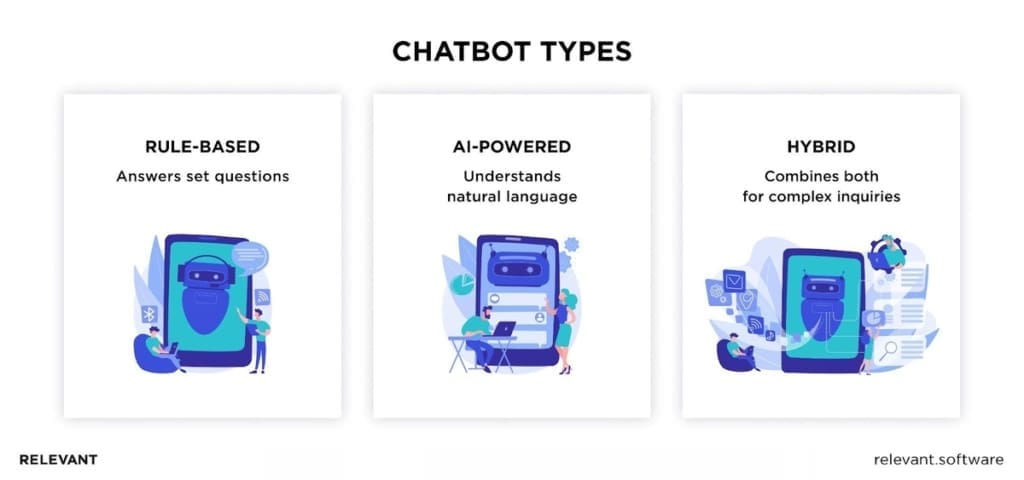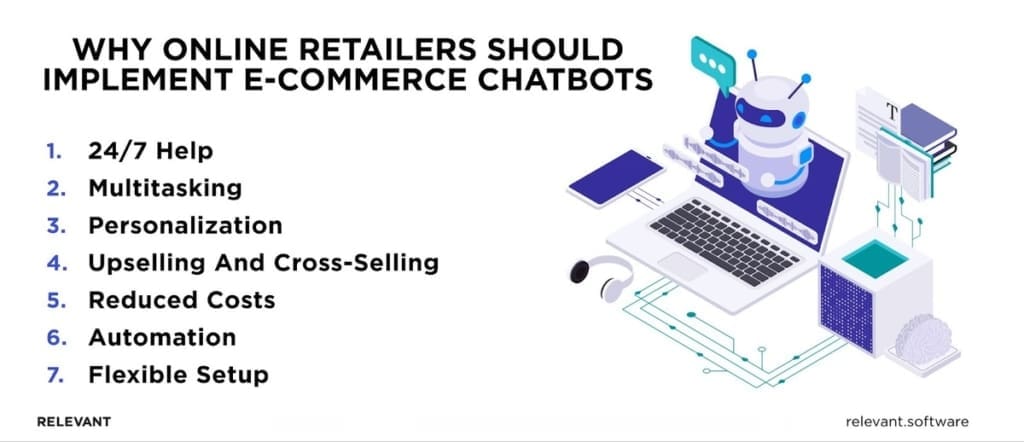Power Up Your Online Store: The Ultimate Guide to Chatbots for Ecommerce
As an e-commerce store owner, the pressure to stay competitive is always on. Customer experience is king, but staying available 24/7 with limited resources can feel impossible. That’s one of the main reasons why the growing number of online stores implement chatbots for ecommerce.
Following recent advancements in generative AI and the insane popularity of OpenAI ChatGPT, chatbots are trending now. Due to their affordability and the ability to improve customer satisfaction, chatbots will become the main channel for customer service for 25% of companies by 2027, according to Gartner. That’s worth attention, wouldn’t you agree?

We provide companies with senior tech talent and product development expertise to build world-class software. Let's talk about how we can help you.
Contact usAs a company providing AI chatbot development services, we can tell you that virtual assistants can do many things well: product recommendations, customer support, and so much more. This guide will cover everything you need to know about chatbots for ecommerce, their benefits, and what they can do for your online store. You’ll also find practical steps on how to implement a chatbot and make it work for you.
Table of Contents
What are Ecommerce Chatbots?
Ecommerce chatbot is software that uses artificial intelligence (AI) to imitate the human assistant and interact with customers throughout their shopping experience. Certain actions users take on the website, like clicking on an item or adding one to a cart, can start a chat. These actions prompt the chatbot to jump in and assist customers. They make online shopping feel more personal and supportive, just like getting help from a shop assistant face-to-face. Here’s what chatbots for ecommerce can do:
- Respond to customer inquiries
- Personalize shopping experience
- Help place orders
- Automate sales processes
- Prevent cart abandonment
- Offer support after a purchase
- Link customers with representatives
- Collect feedback
- Track engagement
The chatbot solution can be set anywhere where your customers are: company website, mobile app, social media platforms (Instagram, Facebook), messaging apps (WhatsApp, Telegram), or customer service portals. They also come in different complexities, shapes, and sizes. Basically, there are three main types of chatbots for ecommerce:
- Rule-based chatbots provide responses to predefined questions customers may ask
- Conversational AI chatbots use natural language processing (NLP) to better understand nuanced human language and provide human-like assistance.
- Hybrid chatbots can work in a rule-based mode and switch to AI for handling complex questions.

Benefits of Chatbots for Ecommerce
The use of chatbots in ecommerce has become an excellent way to automate routine tasks and improve consumer service experience. They are cost-effective and can assist your customers 24/7, all while helping you make money. Even a simple ecommerce chatbot solution can offer your company a ton of advantages and address your business needs. Here are some benefits of chatbot in ecommerce you can enjoy:

- 24/7 availability and immediate response times. Your customers get answers and assistance anytime, anywhere. Immediate responses build trust and keep the buying momentum going, leading to increased sales and happier customers.
- Handling multiple queries simultaneously. A single chatbot for ecommerce can respond to thousands of customer queries at the same time. It greatly reduces wait times and improves overall customer satisfaction.
- Personalized shopping experiences. AI chatbots for ecommerce can recommend products based on browsing history or past purchases so each customer can enjoy a more engaging and relevant experience.
- Upselling and cross-selling made easy. Virtual assistants can drive sales by subtly suggesting complementary products that enhance the shopper’s experience.
- Reducing the need for large customer support teams. By automating routine inquiries and transactions with a chatbot solution, you can reduce your customer support staffing needs.
- Automating routine. Chatbots for ecommerce can automate repetitive tasks like answering FAQs and processing returns, saving you time and resources that can be reinvested in other areas of your business.
- Ease of integration and customization. Setting up and customizing conversational agents doesn’t require extensive technical knowledge. You can tailor the bot personality to fit your brand voice and specific needs, ensuring a seamless and on-brand experience for your customers.
The Best Ecommerce Chatbots Examples
Shoppers today want quick, reliable customer service from their favorite brands, no matter where they are or what device they’re using. And let us tell you, businesses that have brought chatbots into their online stores are seeing some pretty amazing results. Check out these successful examples of chatbots for ecommerce and see how they change the game.
H&M
The fashion giant H&M launched a chatbot on the Kik platform that interacts with users by inquiring about their fashion preferences and presenting photo choices for selection. Using these responses, the bot creates a personalized fashion profile for each user to recommend outfits and guide shoppers toward making a purchase. Users can also design their own outfits and vote for the outfits created by others. Such a shopping experience is more engaging and interactive.

Source: BDC
Group Dynamite
The company has introduced an AI chatbot for ecommerce on Facebook Messenger to offer 24/7 customer support. Their dual-language chatbot engages with shoppers across all of Groupe Dynamite’s online stores. Customers can get answers to FAQs and inquiries about their orders as well as get informormation on payment options. Their ecommerce chatbot also makes it easier for shoppers to find and purchase items.
DeSerres
DeSerres, a top Canadian art and hobby supplies retailer, launched an AI chatbot to handle the surge in demand and increased customer inquiries. A key feature of their virtual assistant is product recommendations. It asks the customer what they’re searching for and then offers suggestions for available items. Customers can easily click through to learn more about a product and proceed to purchase it on the following page.
As you can see, integrating chatbots into ecommerce platforms has proven to be one of the best solutions for enhancing customer service and improving the shopping process.
Implementing Chatbots for Ecommerce: Steps
If the thought of making a chatbot ecommerce seems daunting due to a lack of coding knowledge, fear not! There are numerous platforms out there for developing chatbots for ecommerce that accommodate different skill levels. Here, we’ll not focus on a specific platform but rather outline the key steps that will help you implement ecommerce chatbots for your website regardless of the chosen platform.

Define Your Objectives and Understand Your Audience
Launching a chatbot for ecommerce platform requires a clear understanding of its purpose and a target audience’s needs and preferences from the get-go. Without clear objectives, you risk confusing both your customers and your team. So, what do you want your chatbot to accomplish? Assist your customer service team, make the shopping experience more engaging, or offer product recommendations? Answering these questions will give you a clear vision and direct the chatbot design decisions. And knowing your audience’s shopping habits and expectations allows you to customize the chatbot’s functionality and communication style.
Choose the Right Technology
With so many platforms for ecommerce chatbots available, you should find the right one that aligns with your project’s needs and satisfies your criteria. And here are two key decisions you need to make.
1. Decide between building a custom solution or using a pre-built platform.
- Pre-built platforms offer easy setup and affordable options with drag-and-drop interfaces and pre-built features. They are perfect for smaller businesses or those starting with chatbots for ecommerce. However, customization options might be limited.
- Building a custom solution. This option offers complete control and flexibility to tailor the chatbot to your specific needs and brand voice. Yet, custom Ecommerce software development requires strong technical expertise and higher investment, making it better suited for larger businesses with in-house development resources.
2. Choose between AI-driven chatbots for more complex interactions and rule-based chatbots for simpler, scripted responses.
- AI chatbots for ecommerce. They use NLP and machine learning to understand complex questions and respond in a natural way. Such chatbots learn from interactions and improve over time, offering a more personalized experience. However, they require more advanced technology and might come at a higher cost.
- Rule-based chatbots follow pre-programmed rules and keywords to answer simple questions or guide users through specific tasks. They are easier to set up and maintain but may feel less interactive and struggle with complex inquiries.
Remember, the best chatbot technology is the one that aligns with your goals, budget, and technical expertise. Thoroughly research your options, and don’t hesitate to seek help from professionals to find the perfect fit for your business.
Design the Chatbot
Once you’ve chosen the right technology, it’s time to design your chatbot for ecommerce. Here’s what you need to do:
- Develop scripts. Write clear, concise, and engaging scripts for different scenarios. They’ll guide the chatbot’s responses and ensure a consistent brand voice.
- Anticipate common queries. Identify the most frequently asked questions and create clear and informative responses for each.
- Design conversation pathways. Map out the conversation flow, including different branching options based on user input. It will allow your chatbot to navigate complex inquiries and guide users to the information they need.

Here are some tips for creating effective scripts and conversation flow:
- Avoid technical jargon and opt for conversational, natural language that feels friendly and approachable.
- Don’t overwhelm users with lengthy responses, and offer clear calls to action.
- Don’t just answer, anticipate what the user might ask next and provide additional information if relevant.
- Inject subtle touches of your brand’s personality into the dialogue to make the chatbot feel more engaging and memorable.
Another critical aspect here is the design of a user interface. It should be intuitive and easy to use, so make sure to include clear navigation buttons, a visible chat history, and easy access to additional resources. What’s more, you want your bot to maintain a consistent design with your brand. That’s why ensure its interface matches your website and app design in terms of colors, fonts, and overall aesthetics.
Integrate with Your Ecommerce Platform
Integrating chatbots into your Ecommerce platform is like fitting a new gear into a well-oiled machine—it should click into place perfectly, enhancing the mechanism’s overall performance. For your chatbot to truly excel, it must blend seamlessly with your operations and become an integral part of the shopping experience. Only then will it be capable of guiding customers through your product catalog, assisting them in making purchases, and providing immediate updates on their orders.

For advanced features of chatbots for ecommerce, you’ll need to integrate with some APIs. Consider adding APIs for payment processing to allow customers to securely complete purchases directly through the chat interface. Likewise, you can connect your inventory management system to keep the chatbot informed about product availability and avoid suggesting out-of-stock items.
Train the Chatbot
Just like a new employee, a chatbot starts its journey by learning the ropes from existing data. You need to train it so it understands your customers and fulfills its role effectively. To do that, use data from your existing customer service interactions like FAQs, emails, and chat logs. Thus, chatbots for ecommerce will learn common questions, appropriate responses, and the tone of your brand’s customer service.

If you decide to build an AI-driven chatbot, the learning process will never stop. Since they use machine learning, bots will learn and improve from their interactions with users over time.
Test and Refine
Before releasing your chatbot to the public, it’s critical to test it thoroughly. Engage with the virtual assistant to evaluate its ability to understand questions, follow the conversation flow, and provide correct information. Fix any technical glitches, scripting errors, or inconsistencies that might hinder the user experience.
Once you’re confident in your chatbot’s performance, consider launching a beta version of it to a limited group of customers before making it publicly available. This allows you to:
- Gather real-world feedback on the bot’s functionality, user-friendliness, and overall effectiveness.
- Identify unforeseen issues that may not have surfaced during internal testing.
- Use the gathered data and feedback to refine your chatbot’s script, conversation flow, user interface, and AI training data (if applicable).
Launch and Promote
Now, you’re ready to launch your chatbot. But before you hit the “go” button, you should plan the launch strategically. Choose peak traffic times and promote through email, social media, and website announcements. Offer incentives and host live demos to spark user engagement. By doing so, you’ll encourage user adoption and establish it as a valuable tool for your customers.
Monitor and Optimize
Just like any successful business venture, chatbots for ecommerce need ongoing monitoring and optimization to maintain their effectiveness. Track the performance against your goals using analytics. Monitor customer interactions, user satisfaction, and conversion rates. Update the script, refine the conversation flow, and retrain the AI (if applicable) based on data. Continuous monitoring and optimization will help you keep your conversational agent relevant and helpful.
Ensure Compliance and Security
Chatbots for ecommerce, much like chatbots in healthcare, shouldn’t compromise trust. That’s why you should ensure compliance with data protection laws like GDPR by obtaining informed consent and securing data storage. Be transparent about data practices. Implement robust security measures like encryption and regularly update software to guard against online threats. By prioritizing security and compliance, you’ll foster trust and protect your customers.
Build Ecommerce Chatbots with Relevant Software
Speaking to a robot might seem distant, unemotional, and detached. However, chatbots for ecommerce have surprisingly made numerous brands feel more human and accessible to consumers. As retailers continue to pour resources into this technology and consumers increasingly use (and expect) it, the widespread adoption and importance of chatbots in ecommerce become undeniable.
If you want to turn conversations into customers and save time on customer service with the help of an advanced AI-powered bot but have questions, feel free to reach out to experts from Relevant Software for help. Providing conversational AI chatbot development services, we’ll help you figure out the best solution for your business, considering your current and future needs. Deliver top-quality customer experience at scale with custom chatbots for ecommerce.
Our core services:
Do you want a price estimate for your project?
Do you know that we helped 200+ companies build web/mobile apps and scale dev teams?
Let's talk about your engineering needs.
Write to us











